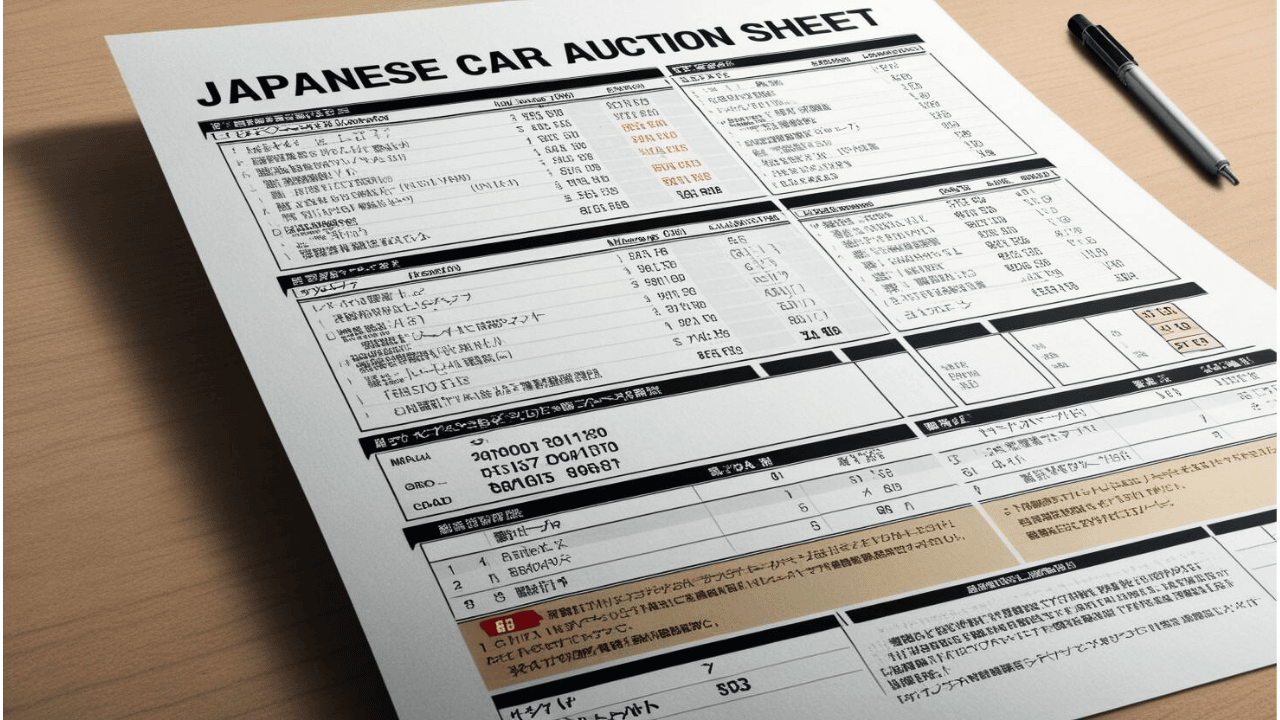
japanese car auction sheet in english
Are you confused by Japanese car auction sheets? Many buyers struggle to understand these important documents. Japanese car auction sheets hold key details about used cars from Japan. Learning to read these sheets in English helps you make smart car buying choices. This guide breaks down everything you need to know about auction sheets so you can buy with confidence.
What is a Japanese Car Auction Sheet?
A Japanese car auction sheet is a report card for used cars sold at auctions in Japan. Think of it as a health report for the car you want to buy.
These sheets tell you:
- Car condition
- Damage history
- Part replacements
- Accident records
- Mileage
- Features
- Engine status
Japanese dealers create these sheets after checking the cars. They use a standard format so buyers can quickly understand the car's status.
Car auction sheets save time for buyers who can't see the cars in person. With millions of cars sold each year at Japanese auctions, these sheets help you pick the best one.
The sheets use grades, codes, and marks to show different problems or good points. Cars with higher grades cost more because they're in better shape.
Many foreign buyers work with agents who help translate these sheets from Japanese to English. This helps you know exactly what you're getting before shipping a car overseas.
Check car auction reports online to see examples of real auction sheets.
Structure of a Japanese Car Auction Sheet
Japanese car auction sheets follow a set layout. Learning this structure helps you find information fast.
Top Section
- Auction House Name: Shows which company ran the auction
- Auction Date: When the car was sold
- Lot Number: The car's ID number at the auction
- Registration Year: When the car was first registered
- Car Make and Model: Toyota, Honda, etc.
- VIN/Chassis Number: The car's unique ID code
- Grade: Overall condition rating (more on this later)
Middle Section
- Exterior Drawing: A simple car diagram showing damage spots
- Interior Condition: Notes about seats, dashboard, etc.
- Options List: Features like AC, power windows, navigation
- Color Code: The car's paint color
- Mileage: How far the car has been driven
- Engine Type: What engine the car has
Bottom Section
- Inspector Comments: Notes about the car's condition
- Repair History: Past fixes or problems
- Modification Notes: Changes from the original design
- Starting Price: Opening bid amount
- Auction Result: Final selling price
Different auction houses like USS, TAA, and JBA use slightly different formats. But they all include these main parts.
Learn about Japanese VIN checks to verify the car's history beyond the auction sheet.
The sheet uses a mix of Japanese characters, numbers, and special marks. Next, we'll look at how to understand what these grades and marks mean.
Understanding the Auction Grade System
The grade system on Japanese car auction sheets tells you the car's overall condition at a glance. This helps you sort good cars from bad ones quickly.
Basic Grade Scale
Most auction houses use this scale:
- S: New car with very low miles
- 6: Excellent condition, like new
- 5: Very good condition with minor wear
- 4.5: Good condition with some small issues
- 4: Average condition with normal wear
- 3.5: Fair condition with noticeable problems
- 3: Poor condition with many issues
- 2: Bad condition, needing major repairs
- 1: Very bad, often for parts only
- R: Repaired after crash damage
Modified Grade Marks
Sometimes you'll see these marks after the grade:
- A: Minor flaws
- B: Some flaws
- C: Many flaws
- D: Major issues
For example, a 4B car is average with some flaws.
Interior Grade
The inside of the car gets a letter grade:
- A: Like new
- B: Clean with minor wear
- C: Noticeable wear
- D: Bad condition, smelly or damaged
Newer cars with lower miles usually get higher grades. But even old cars can get good grades if well maintained.
Cars graded 4 and above are generally safe choices. Cars graded 3 or below often have serious issues.
Explore different Japanese car auction sites to see how grading works at each one.
Translating the Japanese Car Auction Sheet in English
Most Japanese car auction sheets are in Japanese. This creates a challenge for foreign buyers. Here's how to handle the translation:
Translation Methods
- Hire a Professional: Many export companies offer translation services
- Use Online Tools: Some websites convert auction sheets to English
- Learn Key Japanese Terms: Memorize common words used on sheets
- Get a Digital Translator: Apps can help translate text from photos
Common Japanese Terms and Their English Meanings
|
Japanese Term |
English Meaning |
|
修復歴 |
Repair History |
|
走行距離 |
Mileage |
|
外装 |
Exterior |
|
内装 |
Interior |
|
エンジン |
Engine |
|
年式 |
Model Year |
|
色 |
Color |
|
自動車 |
Automobile |
Reading Damage Codes
Auction sheets use special codes to mark damage:
- A: Scratch
- U: Dent
- W: Wave (ripple in the metal)
- S: Rust
- C: Corrosion
- P: Paint fade
- Y: Repair
- XX: Replaced part
These codes appear on the car diagram with numbers showing the damage size:
- Very small
- Small
- Medium
- Large
For example, "A1" means a tiny scratch.
Check past auction bid history to see how condition affects prices.
How to Read the Japanese Car Auction Sheet
Reading auction sheets step by step makes the process simpler:
Step 1: Check the Basic Info
First, look at the car details:
- Make and model
- Year
- Mileage
- Color
- Engine size
- Transmission type
Step 2: Study the Grade
The overall grade tells you the car's basic condition. Remember that a grade 4 or higher usually means a good car.
Step 3: Examine the Car Diagram
The sheet includes a drawing of the car with marks showing:
- Scratches
- Dents
- Rust spots
- Repairs
- Replaced parts
Look carefully at this diagram. More marks mean more problems.
Step 4: Read the Inspector Comments
The comments section has notes from the person who checked the car. This often includes:
- Running condition
- Noise issues
- Smell problems
- Special features
- Warning lights
- Interior damage
Step 5: Check for Repair History
Look for the "修復歴" (repair history) section. If marked with "あり" (yes), the car has been in an accident. If marked "なし" (no), it hasn't had major damage.
Step 6: Review Options and Equipment
The sheet lists features like:
- Air conditioning
- Power windows
- Navigation system
- Airbags
- Special wheels
- Audio system
Learn how to buy directly from Japanese auctions after mastering auction sheets.
Why Should You Care About the Auction Sheet?
Auction sheets matter for several key reasons:
Spot Hidden Problems
The sheet shows issues you can't see in photos. Small marks on the sheet might mean big problems in real life.
Avoid Scams
Some sellers hide car problems. The auction sheet gives you the real story from professional inspectors.
Know the True Value
Cars with better grades and fewer problems are worth more. The sheet helps you pay a fair price.
Plan for Repairs
When you know what's wrong with the car, you can budget for fixes before buying.
Make Better Choices
With auction sheet knowledge, you can pick between similar cars based on their true condition.
Resale Value
If you want to sell the car later, having the original auction sheet helps prove its condition and history.
Buying without checking the auction sheet is like buying a used phone without testing it first. You're taking a big risk.
Learn about add-on costs like window tinting to budget for your imported car.
FAQs of apanese car auction sheet in english
Can I get an auction sheet for any Japanese used car?
Not all used cars from Japan come with auction sheets. Only cars sold through auctions have these sheets. Private sales and dealer trade-ins might not have them.
How accurate are the grades on auction sheets?
Grades are mostly accurate but still based on human judgment. Different inspectors might give slightly different grades to the same car.
Do auction sheets show odometer tampering?
They try to spot it, but very skilled tampering might not be caught. Look for notes about mileage being "suspicious" or "unverified."
Can auction sheets be faked?
Yes, some dishonest sellers make fake sheets. Always get sheets from trusted sources, not just the seller.
How long should I keep the auction sheet?
Keep it for as long as you own the car. It helps with resale and proves the car's history.
What if the car has no auction sheet?
Be extra careful. Ask for other proof of condition and history. Consider having the car inspected by a mechanic.
Are digital auction sheets as good as paper ones?
Yes, many auction houses now use digital sheets. They contain the same information as paper sheets.
Can auction sheets predict future problems?
No, they only show the condition on inspection day. Regular maintenance is still needed.
Common Mistakes to Avoid When Interpreting Auction Sheets
Even with an English translation, you can still misread auction sheets:
Ignoring Small Marks
Small marks can mean big problems. An "A1" (tiny scratch) near the roof might mean water damage inside.
Focusing Only on Grade
A high grade doesn't mean a perfect car. A grade 4.5 car might still have replaced parts or minor damage.
Misunderstanding Repair History
"修復歴なし" (no repair history) doesn't mean the car is damage-free. It just means no major structural repairs.
Not Checking Auction House Standards
Different auction houses have different grading systems. A grade 4 at one place might be a 3.5 at another.
Missing Hidden Codes
Some sheets use special marks that aren't explained in the legend. Research unusual symbols you don't understand.
Overlooking Mileage Verification
Check if the mileage is marked as verified or unverified. Unverified mileage could be wrong.
Assuming All Problems Are Listed
Inspectors can miss things. The sheet shows what they found, not everything wrong with the car.
Learning to read Japanese car auction sheets takes practice, but it's worth the effort. This skill helps you find great cars at good prices while avoiding expensive mistakes.
Visit Car Auction Report for more help with Japanese car imports and auction sheets.
Tags
Also Read

japanese car auction sheet in english
Understand the Japanese car auction sheet in English with our detailed guide. Learn how to decode grades, conditions, and ratings ...
| 22/05/25

Japan Auction Sheet Verification
Professional Japan Auction Sheet Verification – avoid fraud, confirm vehicle specs, and get a true assessment of auction sheet details. ...
| 21/05/25

How to Buy a Car in Japan Auction
How to Buy a Car in Japan Auction with steps on bidding, inspection, payment, and shipping process for secure and ...
| 29/04/25

how much does window tinting cost
Find out how much does window tinting cost based on vehicle type, tint quality, and installation method. Compare prices and ...
| 28/04/25

Car Auction Bid History: Unlocking the Secrets to Smarter Bidding
Car Auction Bid History with real-time updates on bids, winning amounts, and buyer interest. Track past and current auction activity ...
| 24/04/25